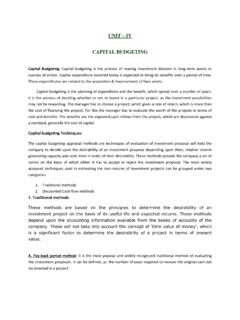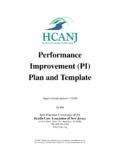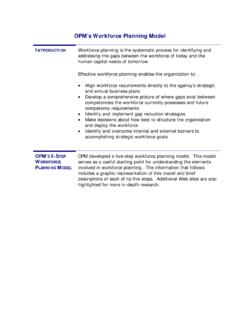Transcription of Building a Culture of Continuous Improvement
1 Building a Culture ofContinuous ImprovementGUIDEBOOK AND TOOLKIT 2019 Education Development Center. All Rights Reserved. This work may not be reproduced, sold, or otherwise disseminated without the express written consent of Education Development Center, UsEducation Development Center (EDC) is a global nonprofit that advances lasting solutions to improve education, promote health, and expand economic opportunity. Since 1958, we have been a leader in designing, implementing, and evaluating innovative programs, in collaboration with public and private partners.
2 From in-depth research endeavors to district- and country-wide reform initiatives, our programs provide individuals, families, and communities with the knowledge, skills, and support they need to achieve a better future. Education Development CenterThis publication may be shared without charge for educational, charitable, nonprofit or other non-commercial purposes. Such use must include acknowledgement that it is with the permission of Education Development Center. All other use is prohibited without the prior written permission of EDC. For permission requests, please contact communications at or EDC, we believe in the value of organizational learning and Improvement .
3 We have long been committed to supporting schools, districts, state agencies, community organizations, and other partners in designing, implementing, and sustaining effective practices, programs, and policies. To that end, EDC provides tools, resources, and services to help partners build capacity for a working Culture of collaboration, reflection, inquiry, problem solving, and Improvement toward equitable outcomes. We focus on both the technical and adaptive qualities of systems reform, which we consider to be necessary for transformational change. This guidebook is designed for learning organizations that are committed to empowering practitioners and leaders to improve conditions in complex education systems.
4 The conceptual framework and design of this guidebook is rooted in research and experience. We build on scholarship from implemen-tation science, systems change, Continuous Improvement , and scale. EDC also engaged in an iterative design process and used lessons learned from our education partners to inform the final design of this guidebook. We would like to thank the Nellie Mae Education Foundation for supporting our work and giving us an opportunity to develop this resource. We are also eternally grateful to educators, administrators, leaders, community partners, and others who provided meaningful feedback throughout the various stages of development.
5 Eliza FabillarSenior Project DirectorEducation Development CenterApril 2019 Contents Overview: Principles to Guide Continuous Improvement 10 Introduction 11A. What is Continuous Improvement ? 11B. An Integrated Model for Improvement 13C. The Importance of Culture and Human capital 15D. Guiding Principles for Continuous Improvement 17 Tool: Continuous Improvement Organizational Self-Assessment Survey 17 Tool: Building Capacity of Education Professionals for Deep Learning 17 Chapter 1: Build Common Purpose and Understanding 24 Introduction What is a Theory of Change?
6 Defining the Goal Empathize, Analyze, Understand What is a Problem of Practice? Developing a Theory of Change 33 Tool: Driver Diagram 38 Chapter 2: Support System Alignment and Change 40 Introduction A Human-Centered Systems Change Reflective process System Mapping of People, Practices, Programs, and Policies Strategies for Change Management Applying Theory to Practice: A Case Study 53 Tool: Systems Alignment Template 57 Tool: Change Management 57 Chapter 3: Plan for a Cycle and Implement 58 Introduction Identifying a Suite of Change Practices A Method for Improvement .
7 Plan-Do-Study-Act (PDSA) Types of Improvement Data and Measures A Case Study Complete a Data Collection Plan Study 72 Tool: Plan-Do-Study-Act Template 73 Chapter 4: Study, Reflect, and Act 76 Introduction Guidelines for Maintaining a Focus on Equity Compiling and Organizing Data Collaborative Data Study Making Decisions and Actions Based on Lessons Learned Documenting Your Story: Continuous Improvement Journey Map 89 Tool: Protocol for Collaborative Data Study 93 Tool: Journey Map 93 Chapter 5: Scale for Depth and Breadth 96 Introduction Scaling Effective Practices for Depth and Breadth Rubric for Scaling Effective Innovations and Practices Scaling Effective Practices: Case Study and Exercise Continuous Improvement and Scale 109 Tool: Diagnostic Tool for Scale 109 WHAT ISHow can it help your organization?
8 Can you integrate it in the context of systems change? How can you work collaboratively to promote learning and Improvement ? Improvement ?CONTINUOUS7 Building a Culture of Continuous Improvement GuidebookIntroductionWhat is Continuous Improvement ? How can it help your organization? How can you integrate Continuous Improvement in the context of systems change? How can you work collaboratively to promote organiza-tional learning and Improvement ? This guidebook is designed to demystify Continuous Improvement and help you build capacity to effectively engage in the guidebook is organized around five key phases as illustrated below.
9 EDC s integrated Continuous Improvement model reflects an iterative process and supports a holistic, comprehensive approach to change. Build common purpose and understanding01 Support system alignment and change02 Scale for depth and breadth05 Plan for a cycle and implement03 Study, reflect,and act04 BuildcollaborativecultureManagethe changeprocess8 Building a Culture of Continuous Improvement GuidebookBefore outlining each chapter in detail, here are a few things to know about how this guidebook is organized: Case studies and examples are included to make it easier to understand information and bridge theory with practice.
10 The examples provided are based on the real experiences of schools, districts, and state agencies. Templates are provided to guide your work, and you may adapt them to meet your needs. Short exercises are embedded within the chapters to help you reflect and retain new ideas. Tips and highlights appear in the guidebook to help you think about how you can apply strategies to your local context. Synthesis of research literature is included throughout the guidebook to provide background information or a rationale for an approach. Specific frameworks and approaches are provided, and you may adapt ideas to your local context.













